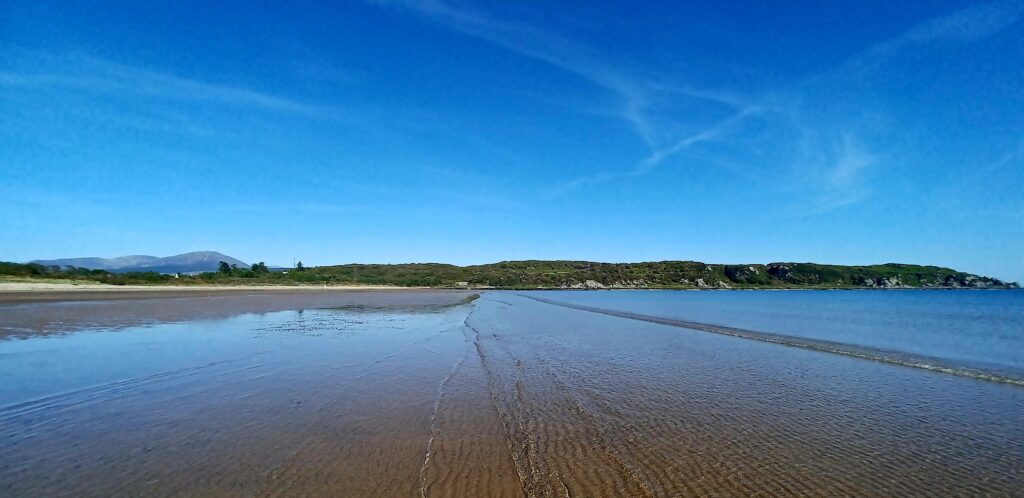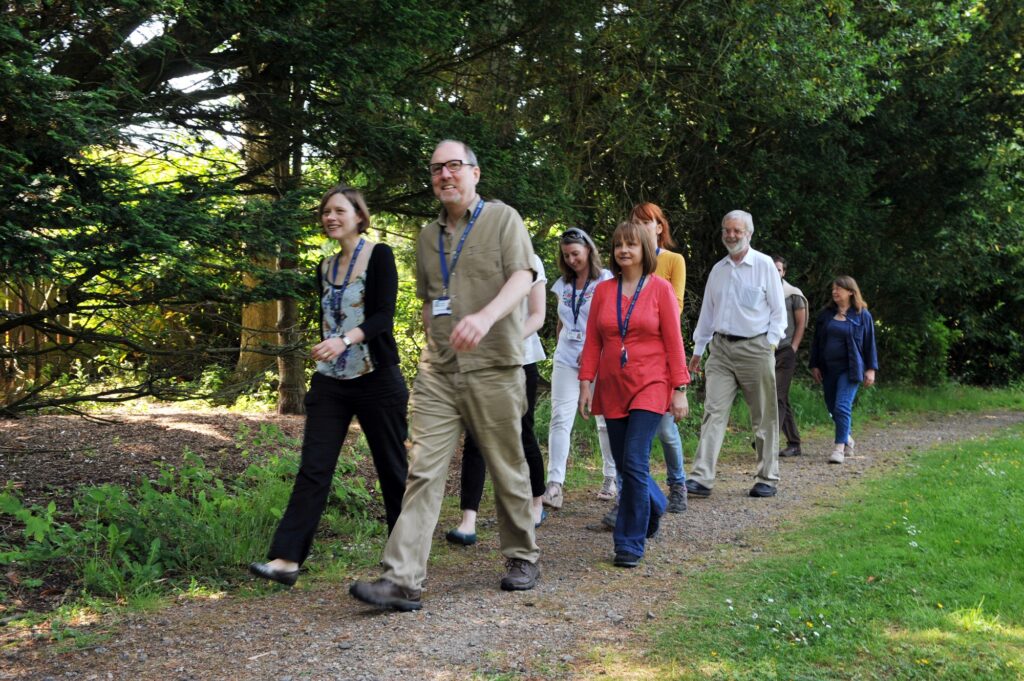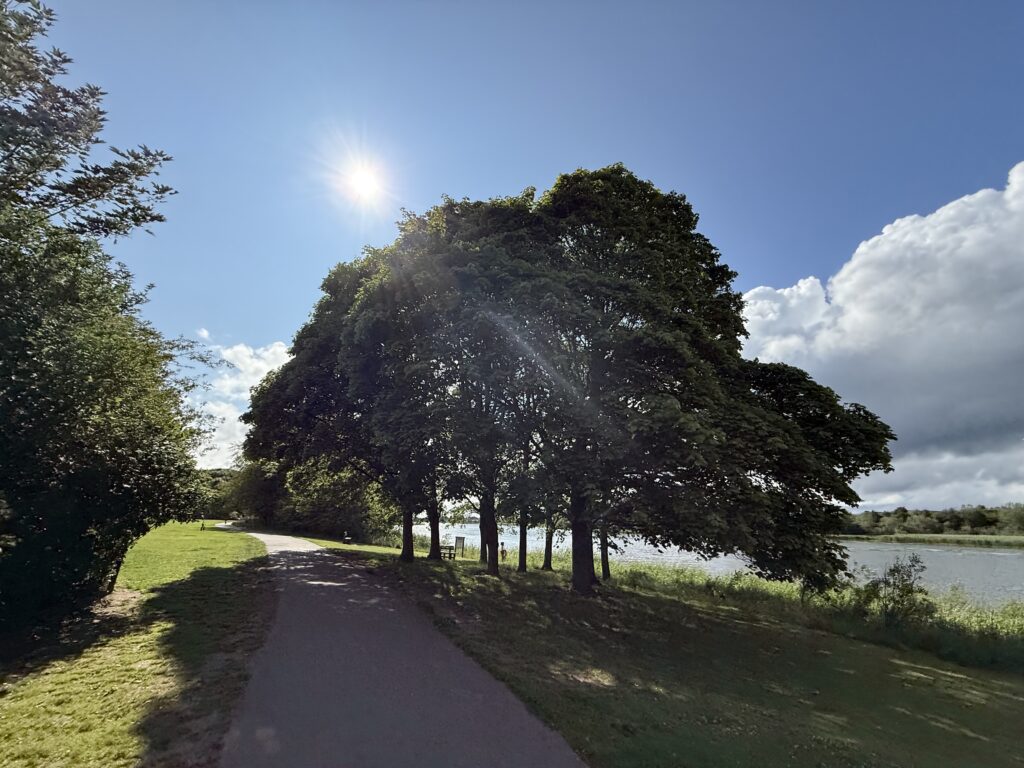Stepping together – SEGS reflections on the Spring Step Count Challenge 2025
Up for the challenge!
Every year in spring and autumn, Scotland’s national walking and wheeling charity Walking Scotland (formerly Paths for All) operate a national ‘Step Count Challenge’ (SCC) championing everyday walking in and around the workplace – but also extending to all steps taken in life more generally. The challenge is pitched as an inclusive and fun opportunity for colleagues to come together to improve their health and wellbeing and encourage healthier habits, which might include walking to work, lunchtime walks, and walking meetings.
Twenty members of the Social, Economic and Geographical Sciences (SEGS) department signed up to participate in the 2025 Spring SCC from Monday 5th May until Sunday 29th June.
Participants logged their daily steps on an online platform and watched their step count grow and contribute to the overall totals of four randomly assigned and colourfully named SEGS teams: The Walky Horror Picture Stroll, Joyful and amazing strolling team (JAAST), Cirque du sore legs, and Red Hot Chilli Steppers, each made up of five team members.

Team SEGS
In the end, there was a strong sense that ‘Team SEGS’ was more significant that the administratively necessary team divisions, facilitated by an online Webex group chat and through informal interactions in the department.
Tony and Mags said:
I didn’t really feel particularly competitive, but I liked the general sense that we were all (the wider SEGS group participating in this) intentionally deciding to prioritise walking for a while.
I thought it produced a nice atmosphere in the department and got people to mix.
Over the course of the challenge Team SEGS collectively achieved more than 1.5 million steps each week (roughly the equivalent of walking around the Aberdeenshire and Moray coast to Inverness and completing a circuit of the North Coast 500) equalling an impressive total 12,397,663 steps for the 8-week period.
Some stand out performances within the team included Eilidh Dillon, who walked more than 1 million steps (averaging 18,485 steps/day) and Anna Williams who achieved her target of 413 miles (935,550 steps) – the distance from Aberdeen to her hometown in Wales.
Each team member’s approach to the challenge was in keeping with individual lifestyle, circumstances, and motivations. Some generating an inspiring number of steps on their daily commute, others utilising time while their children attended evening clubs, and everyone making the most of the beautiful spring weather and getting outside at the weekends, on some occasions reaching daily totals of over 30,000 steps.
Throughout the challenge the group shared photographs with each other from weekend, holiday, and daily walks, ranging from Couper’s Pond on the Institute grounds, Duthie Park, and Brimmond Hill in Aberdeen; locations across Scotland including Mount Keen, the Cairngorms, Stonehaven, Forfar Loch, the Moray Coast, Durness, and Argyll; and beyond, including Yorkshire, Buckinghamshire, and Galicia in Spain. As well as the many (many) steps counted on the pavements of Aberdeen, members of our team counted steps in places as far flung as Machu Pichu, in Peru.
Fiona said:
“Throughout the challenge it was really nice to hear about what colleagues were doing to increase their steps, seeing photos of their walks, and hearing various stories too.”
New ways of working, new ways of walking…
When the Step Count Challenge started in 2011, for many people ‘going to work’ represented a different prospect than it does today. Several members of SEGS remember taking part in the early years of the challenge and participating in group walks in and around Craigiebuckler.
Kirsty and Tony reflected:
Glad we have started doing this again, I think it’s an excellent initiative.
I remembered when we did this years ago, and it was a nice memory, and a good reminder to prioritise getting up and walking around during the day – even just walking round the building.
Hybrid working has become an increasingly common practice in the years since the Covid pandemic where employees, including many at the James Hutton Institute, are facilitated in a combination of on-site and remote working. This working pattern is reported to have had a positive impact on time spent on exercise, sports, and wellbeing as employees spend less time commuting1, and presents a new and interesting dynamic to participating in work-place based interventions such as the Step Count Challenge.
Interestingly, there was a sense that working from home removed the opportunity for ‘passive’ steps (which were described as those taken to get places in daily life, such as commuting) and necessitated a different type of effort and awareness to go for a walk. In this instance the SCC acted as a form of reminder to get outside, perhaps for a lunchtime walk or screen break, or to make the effort to walk in the morning or in the evening before or after work, sometimes finding new places to walk or new reasons to spend time outdoors.
Christina and Anna said:
For me, the step challenge then became a marker of just being outside, a reminder that being active for however long outside the house is time well spent.
Towards the end I found it easier to just go out and walk with no purpose. I found podcasts useful to stick on and walk until I’d finished the episode.
Other team members used the SCC as motivation to adapt their commute – whether by walking more regularly instead of taking the car or by walking parts of their usual bus route. In describing their experiences of walking more as part of the SCC, these colleagues described examples of feeling ‘less stressed’ not having to coordinate bus times and ‘deliberately extending walks back from work’ to make the most of the nice weather. Those working in the building also encouraged each other to get outside and walk together.




Looking ahead
In an increasingly sedentary and indoor world, initiatives like the Step Count Challenge serve as a reminder to keep our bodies moving and make the most of being outdoors. At Hutton we conduct research to help improve the world we live in and support people to live better, but participation in this challenge has shown that we also benefit from colleagues and friends reminding us, and indeed joining us, for a lunchtime walk or an afternoon screen break – or sharing a photograph capturing a moment outdoors in a beautiful environment.
Even when walking alone, initiatives like the SCC can support behaviour change and habit formation underpinned by a form of cultural contract that normalises and rewards the behaviour socially as well as physically.
Studies have shown the biggest perceived barrier to walking more often in Scotland is the weather2, which was also reflected in comments by the SEGS group, as the ‘longer evenings and sunny days’ directly contributed to participants inclination to go outside in the evening or take a break from the computer screen during the day. It was also suggested that the type of motivation to spend time outdoors during the spring and summer months often disappears with the daylight and nice weather.
Eilidh said:
I felt able to go for a walk at 9pm and get back at 10 and be confident it would still be light, whereas in winter, when it’s dark at 5pm I don’t have any motivation at all.
The impact of seasonality on walking behaviours is particularly important in the context of natural environments, which are unlit for significant portions of the day during the autumn and winter months in Scotland, but also in urban environments where concerns for safety increase and feelings of enjoyment decrease during the months of dark mornings and evenings.
The prospect of extending participation in the Step Count Challenge in future years to include staff in other departments and include the spring and autumn challenges could allow for action research to be conducted, allowing us to better understand impacts on productivity and wellbeing, as well as habit formation, the significance of walking in different environments and seasons, cultural behaviours (e.g. normalisation of walking meetings, screen breaks, or lunchtime walks), and shared experiences (e.g. walking groups and/or group chats sharing photographs and experiences).
Blog by Sharon Flanigan, with contributions from Team SEGS
Disclaimer: The views expressed in this blog post are the views of the author, and not an official position of the institute or funder.
1. ONS. Who are the hybrid workers? https://www.ons.gov.uk/employmentandlabourmarket/peopleinwork/employmentandemployeetypes/articles/whoarethehybridworkers/2024-11-11 (2024).
2. The Scottish Government. Let’s Get Scotland Walking: The National Walking Strategy. https://www.gov.scot/publications/lets-scotland-walking-national-walking-strategy/documents/ (2014).
